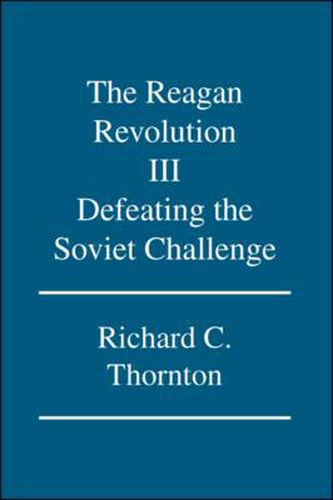Readings Newsletter
Become a Readings Member to make your shopping experience even easier.
Sign in or sign up for free!
You’re not far away from qualifying for FREE standard shipping within Australia
You’ve qualified for FREE standard shipping within Australia
The cart is loading…






This title is printed to order. This book may have been self-published. If so, we cannot guarantee the quality of the content. In the main most books will have gone through the editing process however some may not. We therefore suggest that you be aware of this before ordering this book. If in doubt check either the author or publisher’s details as we are unable to accept any returns unless they are faulty. Please contact us if you have any questions.
Volume III of the Reagan Revolution series recounts the president’s successful defeat of the Soviet drive for global hegemony–for strategic weaons superiority, political domination of the Eurasian landmass, and decisive leverage over world oil. In volumes I and II of this study I analyzed the president’s decisions to jettison the failed strategy of detente and seek victory in the Cold War. In broadening the nation’s economic base to sustain a more powerful military capability, he confronted the Soviet military challenge. Simultaneously, he worked to rebuild the Western Alliance, which had disintegrated during the detente years.
In this volume I show how Reagan foiled the Soviet drive for strategic weapons superiority with a complex, high technology weapons buildup and a surprise shift to strategic defense, inaugurating a fundmental change in the national security equation. He neutralized the Soviet attempt to dominate the Eurasian landmass with the SS-20 missile by deploying the Pershing II/cruise missile package to Western Europe. And he blocked the Soviet drive to shift Iran into its orbit thereby preserving the secure flow of oil to the west and opening the door to an improvement of reltions with Iran.
Recognizing that the Soviet Union was overextended, fueling revolutionary movements on four continents and deeply mired in Afghanistan, the president raised the costs of competition for the Soviet economy already laboring under the heavy burden large-scale military expenditures. He worked for reduced energy prices, reducing Soviet hard-currency earnings, while at the same time blocking the transfer of high technology upon which the Soviet Union depended to remain competitive with the United States. By the middle of 1984 the Soviet leadership concluded that its strategy had failed and would have to be changed.
$9.00 standard shipping within Australia
FREE standard shipping within Australia for orders over $100.00
Express & International shipping calculated at checkout
This title is printed to order. This book may have been self-published. If so, we cannot guarantee the quality of the content. In the main most books will have gone through the editing process however some may not. We therefore suggest that you be aware of this before ordering this book. If in doubt check either the author or publisher’s details as we are unable to accept any returns unless they are faulty. Please contact us if you have any questions.
Volume III of the Reagan Revolution series recounts the president’s successful defeat of the Soviet drive for global hegemony–for strategic weaons superiority, political domination of the Eurasian landmass, and decisive leverage over world oil. In volumes I and II of this study I analyzed the president’s decisions to jettison the failed strategy of detente and seek victory in the Cold War. In broadening the nation’s economic base to sustain a more powerful military capability, he confronted the Soviet military challenge. Simultaneously, he worked to rebuild the Western Alliance, which had disintegrated during the detente years.
In this volume I show how Reagan foiled the Soviet drive for strategic weapons superiority with a complex, high technology weapons buildup and a surprise shift to strategic defense, inaugurating a fundmental change in the national security equation. He neutralized the Soviet attempt to dominate the Eurasian landmass with the SS-20 missile by deploying the Pershing II/cruise missile package to Western Europe. And he blocked the Soviet drive to shift Iran into its orbit thereby preserving the secure flow of oil to the west and opening the door to an improvement of reltions with Iran.
Recognizing that the Soviet Union was overextended, fueling revolutionary movements on four continents and deeply mired in Afghanistan, the president raised the costs of competition for the Soviet economy already laboring under the heavy burden large-scale military expenditures. He worked for reduced energy prices, reducing Soviet hard-currency earnings, while at the same time blocking the transfer of high technology upon which the Soviet Union depended to remain competitive with the United States. By the middle of 1984 the Soviet leadership concluded that its strategy had failed and would have to be changed.